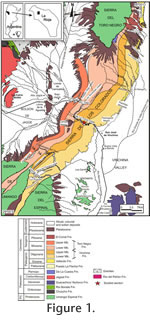| |
INTRODUCTION
 The Vinchina Basin is a thick continental succession deposited under a wide variety of depositional systems (i.e., fluvial, lacustrine and eolian) that bears a diverse and exceptionally preserved ichnofauna. It documents several assemblages of Cenozoic South American trace fossils very different from any other recorded until now. The basin, mostly assigned to the Vinchina and Toro Negro Formations (Turner 1964;
Ramos 1970), crops out at southern South America, at almost 29 degrees South latitude, at northwestern Argentina, La Rioja province (Figure 1). Vertebrate body fossils are lacking at the Oligocene-Early Miocene Vinchina Formation. Conversely, fluvial and lacustrine faces of the unit host a rich invertebrate and vertebrate ichnofauna (Tripaldi et al. 2001;
Krapovickas et al. 2009a;
Melchor et al. 2010). The footprints studied herein are preserved in floodplain deposits of meandering fluvial systems together with other avian and mammalian trace fossils. They consist of tridactyl large cursorial birds, Gruipeda isp., Macrauchenichnus isp., small tridactyl rodent-like mammals, and small tridactyl to tetradactyl footprint with pronounced scratch marks. The overlying Toro Negro Formation (Miocene-early Pliocene) records a rich ichnofauna preserved at exposed sandbars and crevasse-splay deposits of anastomosed fluvial systems developed under a semi-arid climate (Krapovickas et al. 2009b). The invertebrate ichnofauna is composed of meniscate trace fossils (Taenidium
barretti and Scoyenia gracilis), dwelling structures (Palaeophycus tubularis) and grazing trails (Helminthopsis hieroglyphica). The vertebrate ichnofauna includes avian (Fuscinapeda sirin, incumbent footprint, slender anisodactyl footprint) and mammalian footprints (Macrauchenichnus rector, cf. Venatoripes riojanus, small heteropod footprint, kidney-like footprints and oval impressions) (Krapovickas et al. 2009a,
2009b). The Vinchina Basin is a thick continental succession deposited under a wide variety of depositional systems (i.e., fluvial, lacustrine and eolian) that bears a diverse and exceptionally preserved ichnofauna. It documents several assemblages of Cenozoic South American trace fossils very different from any other recorded until now. The basin, mostly assigned to the Vinchina and Toro Negro Formations (Turner 1964;
Ramos 1970), crops out at southern South America, at almost 29 degrees South latitude, at northwestern Argentina, La Rioja province (Figure 1). Vertebrate body fossils are lacking at the Oligocene-Early Miocene Vinchina Formation. Conversely, fluvial and lacustrine faces of the unit host a rich invertebrate and vertebrate ichnofauna (Tripaldi et al. 2001;
Krapovickas et al. 2009a;
Melchor et al. 2010). The footprints studied herein are preserved in floodplain deposits of meandering fluvial systems together with other avian and mammalian trace fossils. They consist of tridactyl large cursorial birds, Gruipeda isp., Macrauchenichnus isp., small tridactyl rodent-like mammals, and small tridactyl to tetradactyl footprint with pronounced scratch marks. The overlying Toro Negro Formation (Miocene-early Pliocene) records a rich ichnofauna preserved at exposed sandbars and crevasse-splay deposits of anastomosed fluvial systems developed under a semi-arid climate (Krapovickas et al. 2009b). The invertebrate ichnofauna is composed of meniscate trace fossils (Taenidium
barretti and Scoyenia gracilis), dwelling structures (Palaeophycus tubularis) and grazing trails (Helminthopsis hieroglyphica). The vertebrate ichnofauna includes avian (Fuscinapeda sirin, incumbent footprint, slender anisodactyl footprint) and mammalian footprints (Macrauchenichnus rector, cf. Venatoripes riojanus, small heteropod footprint, kidney-like footprints and oval impressions) (Krapovickas et al. 2009a,
2009b).
The accurate description of footprints and the identification of possible trackmakers expand the knowledge of their temporal and spatial distribution. Interestingly, the footprints of Cenozoic South American rodents or rodent-like mammals are uncommon in the geologic record. The scarce examples are mostly recorded since the Late Miocene to the Pleistocene of Argentina and were interpreted mainly as hydrochoerids and caviids (e.g.,
Angulo and Casamiquela 1982;
Aramayo and M. de Bianco 2009;
Krapovickas et al. 2009b). Here we present a new footprint ichnogenus and ichnospecies and analyze its putative trackmaker based on anatomical features of the postcranial skeleton that are transcribed to the footprint morphology and trackway pattern. In this context, we discussed its assignation to Dinomyidae (Rodentia, Hystricognathi, Caviomorpha) and the possible expansion of the temporal and spatial distribution of the family.
|
